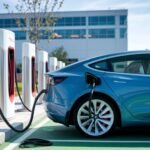Is owning an electric vehicle (EV) cheaper in the long run than sticking with a gas-powered car? It’s a question many drivers are asking as the popularity of EVs continues to rise. With more people considering the switch to electric, it’s essential to break down the real costs associated with EV maintenance versus traditional gas-powered vehicles. Let’s explore the facts to help you make an informed decision.
1. The Basics: EVs vs. Gas Cars
Before diving into the maintenance costs, it’s important to understand the fundamental differences between electric vehicles and gas cars.
- Electric Vehicles (EVs) run on electric power, typically stored in large battery packs. These cars don’t require gasoline and have fewer moving parts than traditional vehicles.
- Gas-Powered Cars use internal combustion engines that burn fuel (gasoline or diesel). These engines are more complex and involve numerous mechanical components, including spark plugs, belts, and fluids.
2. What Drives Maintenance Costs?
Both EVs and gas cars have routine maintenance needs, but the types of service required differ significantly. Here are the key factors that drive maintenance costs for each:
| Maintenance Factor | Electric Vehicles (EVs) | Gas Cars |
|---|---|---|
| Oil Changes | Not required | Regular (every 5,000-7,500 miles) |
| Brake Pad Replacement | Less frequent (due to regenerative braking) | More frequent |
| Transmission Maintenance | Not needed (no traditional transmission) | Regular maintenance required |
| Battery | Expensive to replace, but lasts years | Low-cost battery replacement, more frequent |
| Exhaust System | No exhaust system | Regular exhaust system maintenance needed |
| Coolant | Minimal coolant for battery | Regular engine coolant checks and refills |
| Tire Rotation | Same as gas cars | Same as EVs |
| Belts and Hoses | Very few in EVs | Regular replacement needed |

3. Cost Comparison: Routine Maintenance
When comparing the routine maintenance costs of EVs and gas cars, EVs generally come out ahead, thanks to their simpler design. Here’s a closer look at common maintenance tasks:
- Oil Changes: Gas cars require regular oil changes every few thousand miles, which can cost $30–$100 depending on the vehicle and the type of oil used. EVs, on the other hand, don’t require oil changes at all.
- Brake Pads: EVs use regenerative braking, which reduces wear on brake pads, making replacements less frequent. For gas cars, brake pads may need to be replaced every 30,000–70,000 miles depending on driving conditions.
- Transmission Fluid: EVs don’t have traditional transmissions, which means no need for transmission fluid replacements. For gas cars, this is a maintenance task that can range from $100–$200 depending on the vehicle.
- Battery Maintenance: While replacing the large battery in an EV can be costly (ranging from $5,000 to $15,000), the need for this is rare, with batteries typically lasting 10-20 years. In gas cars, standard battery replacements cost around $100–$200 but are required every 3–5 years.
4. Long-Term Costs: How Do They Stack Up?
Over the long term, the maintenance savings of EVs become even more evident. A report from Consumer Reports suggests that EV owners save around 50% on maintenance costs compared to gas-powered vehicle owners over the life of the car.
Here’s a breakdown of estimated maintenance costs over 100,000 miles:
| Type of Vehicle | Estimated Maintenance Cost (100,000 miles) |
|---|---|
| Electric Vehicle (EV) | $3,000 – $4,000 |
| Gas-Powered Car | $6,000 – $10,000 |
EV owners save significantly, particularly because they avoid costs associated with oil changes, transmission fluid, and exhaust system repairs.
5. EV Battery Replacement: A Major Expense
The biggest maintenance concern for EV owners is the battery. While EV batteries are designed to last, they will eventually degrade, and replacement can be a major expense. However, this typically happens after 10-15 years, and many manufacturers offer warranties for 8 years or 100,000 miles.
If you need a battery replacement after the warranty expires, the cost can be high. Prices vary by make and model, but most EV battery replacements cost between $5,000 and $15,000. Fortunately, battery prices are expected to decrease as technology advances and manufacturing becomes more efficient.
6. Gas Cars: Hidden Maintenance Costs
While gas cars don’t have the looming threat of a battery replacement, they do come with numerous small and medium expenses that can add up over time. This includes regular tune-ups, emissions tests, spark plug replacements, and fuel system cleanings. These services, combined with more frequent repairs due to mechanical complexity, drive up long-term costs.
7. Environmental Costs
Aside from financial costs, it’s worth considering the environmental impact of maintaining gas cars versus EVs. EVs don’t produce tailpipe emissions, reducing air pollution. Additionally, electric motors are more energy-efficient, which means less energy waste overall. Gas cars, however, contribute significantly to greenhouse gas emissions, and regular maintenance (such as oil changes) creates environmental waste.
8. FAQs: EV Maintenance vs. Gas Cars
Q1: Are electric vehicles more expensive to maintain than gas cars?
No, electric vehicles are generally less expensive to maintain than gas cars. EVs have fewer moving parts, no need for oil changes, and fewer routine maintenance tasks, resulting in lower long-term costs.
Q2: How often do EVs need maintenance?
EVs require less frequent maintenance compared to gas cars. Tasks like brake pad replacement happen less often due to regenerative braking, and there’s no need for oil changes or transmission fluid replacement.
Q3: What’s the biggest maintenance expense for EVs?
The most significant potential expense for EVs is battery replacement, which can cost between $5,000 and $15,000. However, this is rare and usually occurs after 10-15 years of use.
Q4: Do gas cars have any advantages in maintenance costs?
While gas cars may have lower upfront costs for things like battery replacements, they require more frequent and varied maintenance tasks, such as oil changes, brake replacements, and transmission repairs, which add up over time.
Q5: How do government incentives factor into maintenance costs?
Many governments offer incentives, such as tax credits or rebates, to reduce the cost of owning an EV. These incentives don’t directly impact maintenance costs but can lower the overall cost of ownership.
9. The Verdict: Which is Cheaper?
When comparing EV maintenance costs to gas cars, EVs emerge as the more cost-effective choice in the long run. Their simpler design results in fewer parts to maintain, and the absence of things like oil changes and exhaust system maintenance keeps costs down. While the high cost of battery replacement may seem daunting, it’s a rare event, and EV owners still save significantly on routine maintenance.
Gas cars, on the other hand, come with a steady stream of small maintenance tasks that add up over time. Though they may not have a single, expensive component like an EV battery, the cumulative cost of tune-ups, fluid changes, and exhaust system repairs makes them more costly to maintain over the vehicle’s lifetime.
If you’re looking to save on maintenance in the long term, going electric is likely the better option. Not only will you enjoy fewer trips to the mechanic, but you’ll also benefit from reduced environmental impact.









